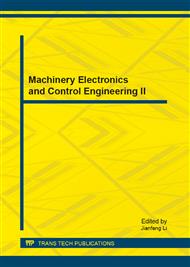p.539
p.544
p.549
p.553
p.559
p.565
p.571
p.579
p.583
Design of Auto-Stabilization Control Technique for a Quadrotor System
Abstract:
This paper presents the design of auto-stabilization control technique for a quadrotor system. Aquadrotor is a highly nonlinear and has to be stabilized by a suitable control technique. Therefore, the main focus of this research is to design an appropriate control algorithm that able to auto-stabilize the quadrotor at hover. The dynamic modeling of the quadrotor is described by sets of equations of motion that are derived based on the Newton-Euler formalism with the implementation of UKF for parameter identification and state estimation. The control strategy adopted includes feedback linearization coupled with Proportional-Derivative (PD) controller for the translational subsystem and backstepping based Proportional-Integral-Derivative (PID) controller for the rotational subsystem. It is developed in MATLAB/Simulink platform and is validated via real-time implementation. Both controllers give satisfactory simulation results, where acceptable peak of overshoot and small steady state errors are achieved. Experimentally, the throttle is controlled in manual mode while attitude angles are stabilized automatically. The simulation and experimental results show that the proposed controller is able to effectively stabillized the quadrotor.
Info:
Periodical:
Pages:
559-564
Citation:
Online since:
March 2013
Price:
Сopyright:
© 2013 Trans Tech Publications Ltd. All Rights Reserved
Share:
Citation:


